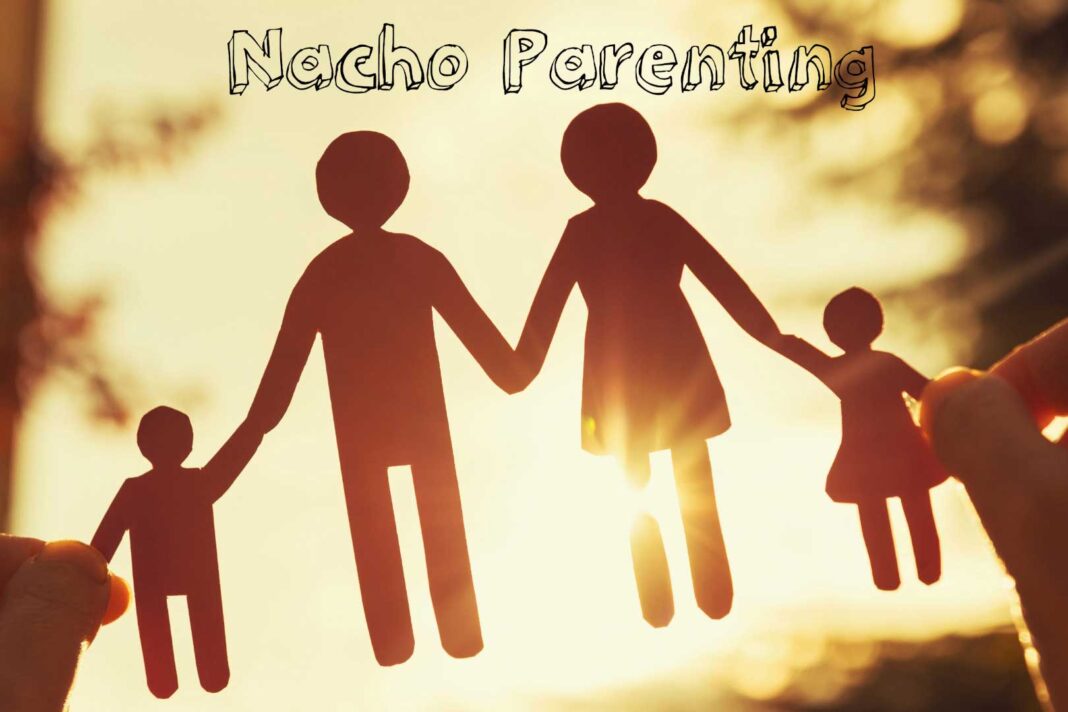Parenting has never been easy for any of us. I admit it myself as a father of two. However, it gets even more challenging for blended families. Any stepparent tries their best to support children. But they typically don’t know exactly how to start and what their roles are. That’s where Nacho Parenting comes in.
Nacho Parenting is a simple method for blended families. The bio parent handles rules, discipline, and consequences, while the stepparent does not interfere. Stepparents focus on being supportive, warm, and kind, not on setting rules. The goal is clear: less fighting, clear roles, and a calmer home. It works best when stepparents feel exhausted, stepkids reject their rules, or parents argue over who is responsible for what.
According to the National Center for Family & Marriage Research at Bowling Green State University, about 35% of unions among women under 50 in the U.S. are stepfamilies. This highlights the importance of finding a practical parenting approach for such situations.
In this guide from FamilyApex, I will share my research results on Nacho parenting and provide clear rules, ready-to-use scripts, and a 30-day plan to help blended families create calmer, healthier homes.
What Is Nacho Parenting (and When It Works Best)?
Nacho Parenting is an innovative parenting method suitable for blended families. The biological parent takes the responsibility for the rules, disciplines, and consequences, while the stepparent does not interfere. The name comes from the phrase “not your kids, not your problem”. It’s estimated that roughly 30–35% of children will live in a blended family with a stepparent during childhood (Source: Psychology Today).
Remember, it does not mean that the stepparent will totally be indifferent toward the child. Instead of setting the rules and considering the punishments, the stepparent offers support, warmth, and kindness, no disciplinarian role for them. The goal is straightforward: fewer conflicts, clearer boundaries, and a calmer home for everyone.
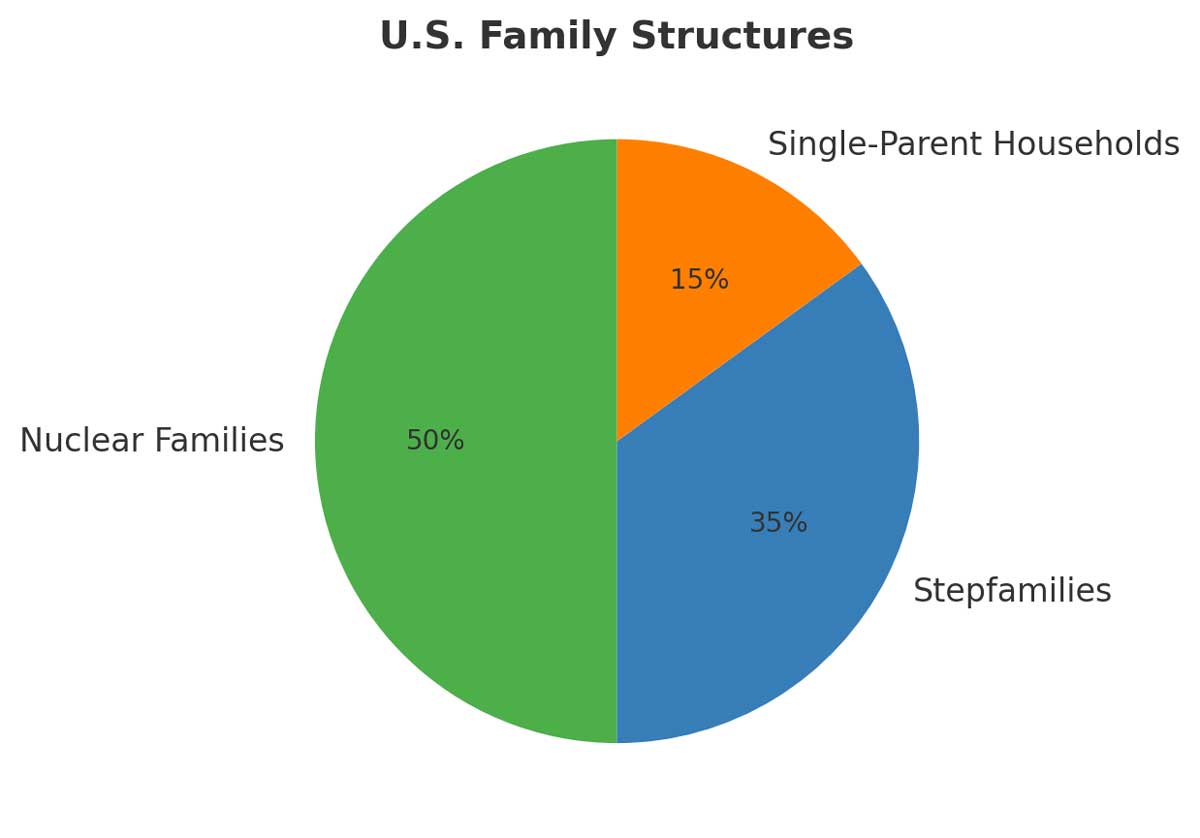
When Does Nacho Parenting Work Best?
As we mentioned at the beginning, blended families encounter issues that the regular ones don’t. Although parenting is not a magic solution for these issues, it can fix many of them to create a calmer environment at home. No stepparent comes to a new family with the wrong intention, but the pressure may change the situation. Nacho Parenting works best when:
- Stepparents feel exhausted or overwhelmed. Stepparents step back to protect their energy and prevent long-term resentment.
- Stepchildren push back against stepparent. Children often refuse to follow rules from someone they do not perceive as a parent.
- Couples argue over “who should handle what.” Arguments about chores, homework, or discipline hurt the relationship. Nacho Parenting sets clear lanes so partners act more like a team.
- There is high conflict with an ex. Nacho Parenting keeps the stepparent out of the drama. The bio parent handles communication.
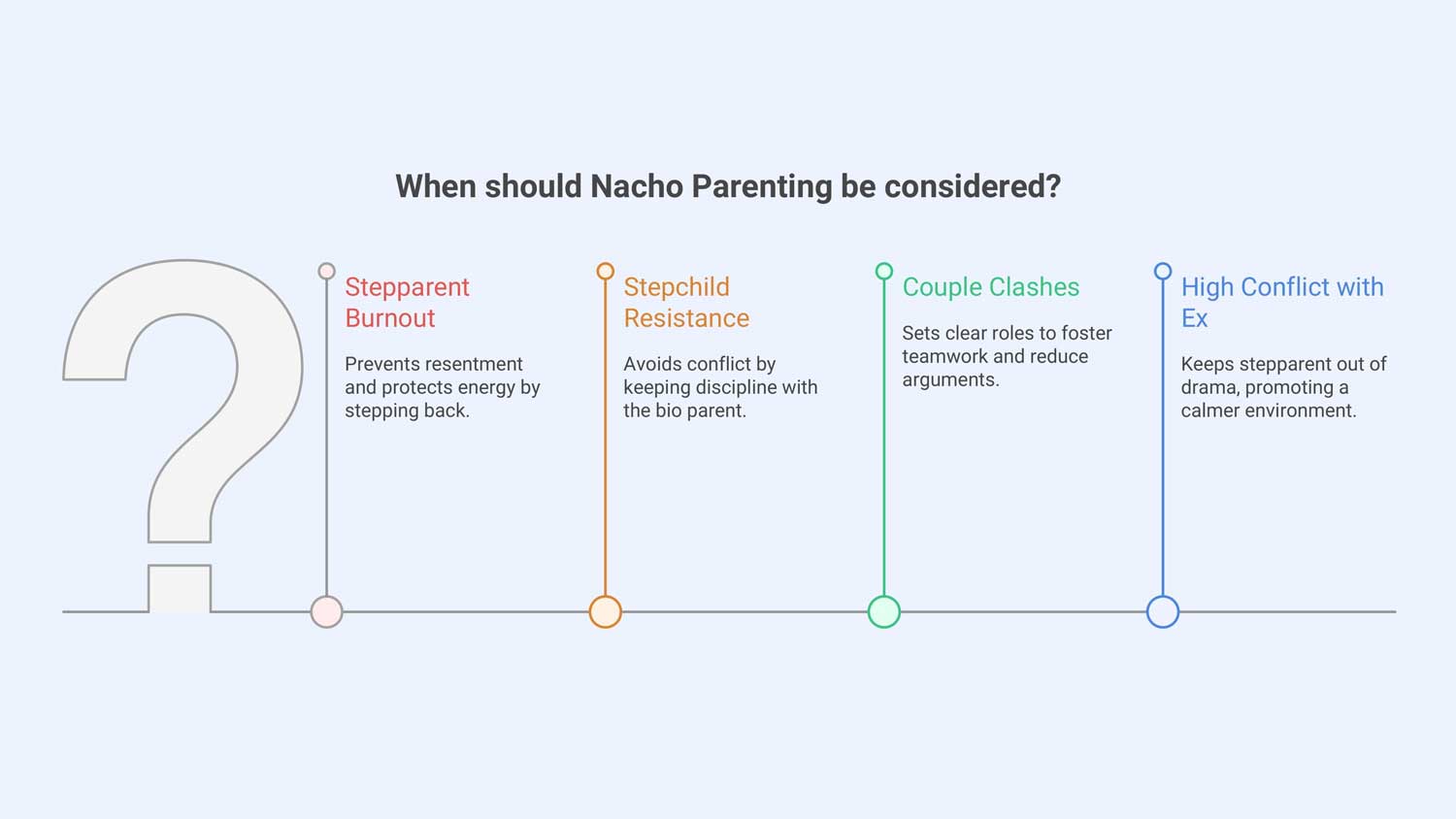
The Main Benefits of Nacho Parenting
Nacho Parenting is not about walking away. It is about finding peace and clear roles in a blended family. The bio parent leads. The stepparent steps back. Everyone knows their place, and life at home gets easier.
According to the Wiley Online Library, research in stepfamilies finds that balancing discipline, family time, and stability is key for child outcomes. Here are the main benefits:
- Fewer arguments at home because the bio parent handles rules and discipline.
- Clear roles so both parents and kids know what to expect.
- Less stress for stepparents and no more disappointment.
- Stronger relationships between partners with fewer fights about parenting.
- More space for stepparents and kids to connect without pressure or power struggles.
What Are the Disadvantages of Nacho Parenting?
Like any other parenting method, Nacho comes with a series of disadvantages. Learning them will help you decide whether you should apply the technique or not:
- Bio parents may feel stressed because they handle all rules and discipline.
- Kids may think stepparent doesn’t care, even if that’s not true.
- Some kids may “parent shop” and try to play parents against each other.
- Nacho Parenting doesn’t work if the bio parent doesn’t take full control.
Here’s a side-by-side look at Nacho Parenting main benefits and disadvantages:
| Aspect | Benefits | Disadvantages | Family Impact |
| Home | Fewer arguments | Bio parent overloaded | Peaceful but stressful for bio parent |
| Roles | Clear roles | Kids “parent shop” | Stability if roles respected |
| Stepparent | Less stress | May seem uncaring | Lower pressure, need balance |
| Couple | Stronger bond | Fails if bio parent passive | Protects marriage if both commit |
| Child Connection | Easier bonding | Risk of distance | Works with small acts of care |
The 5 Core Rules of Nacho Parenting
You will find Nacho Parenting based on five easy-to-track and straightforward rules. Let’s look at five core steps that bring calm, balance, and respect to your family:
1. Let the Bio Parent Make the Decisions
Imagine kids come to you and ask for something, like snacks or more screen time. What do you do as a stepparent? Nacho Parenting says you must let the bio parent make the final decision. I know, you like to answer right away. But, over and over, your kids learn who they should take permission from and do not put you in the hot seat.
2. Step In Only When Safety Is at Risk
As no one can deny, discipline is at the top of the list for blended families’ struggles. With the help of the Nacho Parenting method, you can alleviate the pressure on yourself as a stepparent. It is the biological parents’ duty to set the rules and do the hard work. No interference by the stepparent unless someone’s safety is at risk.
3. Keep It Short, Kind, and Neutral
Arguments with the biological parents are natural, but the ones with step parents usually leave children aggressive and problems unsolved. That’s why Nacho Parenting encourages stepparents to maintain brief, calm, and respectful communication with their stepchildren. Try just to use short responses like, “I hear you, but that’s for Mom/Dad to decide.” This helps lower tension and maintain a steady relationship.
4. Leave Ex-Drama to Your Partner
Many blended families face stress from an ex. Nacho Parenting makes it clear: the bio parent should handle all contact with their ex.
- The stepparent does not reply to texts, emails, or calls.
- Staying out of the drama keeps boundaries clear.
- It protects the stepparent from stress that isn’t theirs to carry.
- It stops kids from feeling caught in the middle of conflicts.
5. Protect Your Own Time, Space, and Belongings
As the stepparent, Nacho Parenting suggests not interfering with setting rules and discipline. However, you still have your own voice in your family. You still set boundaries regarding your time, privacy, and possessions. Boundaries are not about control; they are about respect.
Real-Life Scenario: Screen Time Question at Bedtime
One night, Sarah’s 10-year-old stepson, Ethan, asked to stay up late and watch TV more. Before, Sarah could have said no, but it would have turned into a fight. This time she said, “That’s for your mom to decide. Let’s ask her.” Ethan sighed, but went to his mom. Over time, he learned Sarah was not the one to ask for rule changes, and Sarah stayed out of arguments.
Nacho Parenting Levels: Light, Medium, and Grande
Not every family needs to apply Nacho parenting in the same way as others. In other words, this method is flexible and contains three different levels as follows:
A. Nacho Light
Nacho parenting light is the softest version in which the stepparent is a part of your everyday life and not fully set back. Still, the biological parent handles the main rule-setting aspects, but you are involved in the kids’ homework, meals, and other routine tasks. This is extremely helpful; you don’t struggle with numerous conflicts.
B. Nacho Medium
This method is one step further than the light. You still don’t handle the rules or essential decisions. The stepparent just helps with some tasks whenever you both want. Continue to focus on being respectful and kind. Nacho medium gives everyone in the family the room they need.
C. Nacho Grande
This is the complete reset. It is for high-conflict homes or when stress feels too heavy.
- The stepparent steps away from almost all parenting duties.
- You step in only for safety, emergencies, or basic care.
- You keep talks short and polite, but you avoid power struggles.
- This level gives the family calm time and space to rebuild.
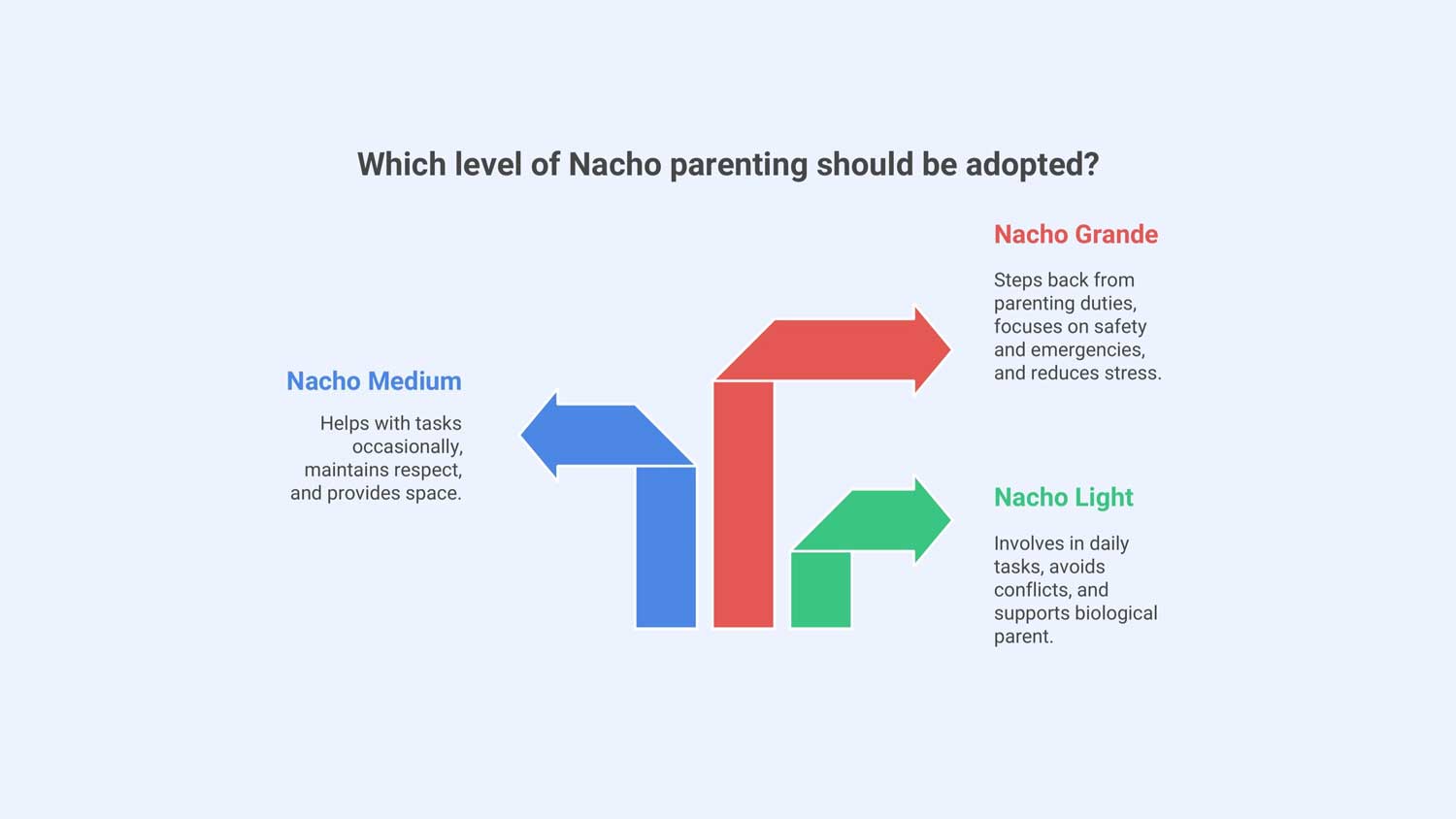
Who Does What in Nacho Parenting? Roles of Bio Parent and Stepparent
To get the most out of Nacho parenting, it is best to ensure that everyone understands their role. In this way, you all will experience less stress, arguments, and fights. Let’s talk about the roles of your family members as follows:
1. The Biological Parent’s Role
The biological parents stay at the forefront of discipline and rules. School matters, health subjects, and any other big choices for the children depend on them. They set expectations, provide consequences, and manage communication with the other parent or ex as well.
2. The Stepparent’s Role
The stepparent focuses on building connection, not control. Their role is choice-based and straightforward:
- Show warmth, kindness, and respect in daily interactions.
- Help with tasks like meals or rides only if they choose to.
- Model good behavior and respect so kids learn by example.
- Focus on relationships, not discipline or control.
3. Shared Roles
Both you, the bio parent, and the stepparent have to share duties to some extent. The boundaries that impact the whole life and home, for instance, are something that you must handle together. Besides, in case of an emergency or when someone’s safety is in danger, you must be present at the same time.
A review of 58 studies on the National Institute of Health found that when parenting partners agree on rules and clearly communicate, children in stepfamilies have better well-being and fewer conflicts. Here’s a quick breakdown of what the bio parent, stepparent, and both together handle:
| Role | Key Duties | Focus | Impact |
| Bio Parent | Rules, discipline, big decisions, ex-communication | Authority | Stability & clarity |
| Stepparent | Connection, kindness, optional help, good example | Support | Trust without conflict |
| Shared | Household boundaries, emergencies & safety | Teamwork | Unity & lower stress |
Nacho Parenting Safety Rules and Essentials
You still have some duties in your family, even as a stepparent. Nacho Parenting does not ignore these duties, either. We all aim to have a better relationship with kids and, of course, care about their mental health as much as required. So, pay special attention to the following items about safety rules and essentials:
1. Safety Comes First
Any danger means the stepparent must interfere. Do not wait for the biological parent to handle the situation. React as quickly as possible in case of abuse, self-harm, or any other dangerous behavior. Safety is always the top rule, and Nacho parenting never ignores it.
2. Essentials Still Matter
Kids need food, care, and rest in every home. If a child is hungry, sick, or tired, you help. Nacho Parenting means stepping back from discipline, not from care. The stepparent must:
- Give food or snacks to kids when they are hungry.
- Help if a child feels sick or needs medicine.
- Ensure they receive rest and comfort when needed.
3. Talk After It Happens
Inform the biological parent about the measures you have taken for the kids’ safety. Let them know if you have prepared food for them, given them medicine, or broken up a fight. In this way, you are fulfilling your role very well while not compromising the role of the biological parent.
Step-by-Step Nacho Parenting Plan for the First 30 Days
You liked the Nacho Parenting method and are looking for a way to incorporate it into your marriage. We have paved your way to Nacho parenting and a much calmer life through a 30-day step-by-step plan for beginners:
Week 1: Align with Your Partner on Triggers and Boundaries
Teamwork comes as the first step in the first week. Together, you and your partner review the reasons for stress and explore how to manage them in the most effective way. Glance at the list below for more:
- Sit together and name the most significant problems (homework, chores, screen time, bedtime).
- Write down the top reasons behind so they are clear.
- Choose which areas the stepparent will step back from.
- Pick short phrases to use, like “That’s a parent call.”
- End the week with a 10-minute check-in to see how it feels.
Week 2: Announce the New Parenting Setup to the Kids
Honesty and clarity are essential for the second week. Share the roles and responsibilities through the steps below to get the best results.
- The bio parent talks to the children about the changes.
- For younger kids, keep it simple: “Mom/Dad will make the rules.”
- For older kids or teens, explain it’s to lower conflict: “I’ll be the one making decisions.”
- Make sure kids know the stepparents are still present but not responsible for discipline.
Week 3: Practice Redirecting, Exiting Conflict, and Staying Warm
Now that you have found the root of the issues and shared the roles, it’s time for action. The stepparent sits back, and the biological parents set the rules. Here is how you should act:
- Redirect questions back to the bio parent.
- Step out of arguments instead of interfering.
- Stay connected by joining games, meals, or simple activities.
- Expect kids to test the new setup. Stay calm and steady.
- The bio parent takes care of discipline and rules.
Week 4: Review Progress and Adjust the Plan Together
In the 4th week, review what you have done and the results. You may need some fixes and changes. Have a look at this list if you ask how:
- Sit down and talk about how the month was.
- Ask: Did conflict fade away?
- Check: Are kids going to the bio parent instead of the stepparent?
- Ask each other how you feel. Calmer, supported, or still stressed?
- Adjust the plan and set one or two goals for the next month.
Real-Life Scenario: A Teen Asks for a School Night Outing
In Week 3 of their Nacho Parenting plan, Mike’s 15-year-old stepdaughter, Lily, asked if she could go to a friend’s house on a school night. In the past, Mike tried to decide, and it always led to arguments. This time, he said, “That’s for Dad to give permission.” Lily rolled her eyes and argued, but Mike walked away. Later, her dad explained the rule and set the consequence. Mike avoided the fight, and Lily knew her dad was the one to decide.
Everyday Nacho Parenting Habits That Make It Work
In every method, some small yet smart moves make a significant difference, and Nacho Parenting is no exception. Some easy-to-do habits can make the process really work as it should. They include:
- Ask Before Acting: Before you respond, stop and ask: “Is this duty for the bio parent’s?” The answer to such a question determines essential boundaries.
- Use Short Scripts: Keep a few simple phrases ready to use. For example: “That’s a parent call.” or “I’m not the decider here.” or “Let’s ask Mom/Dad.” These short scripts keep things calm.
- Do Weekly Couple Check-Ins: Consider 10–15 minutes each week with your partner. Talk about what worked well, what felt tough, and what you want to change.
Signs Nacho Parenting Works and When to Step Back In
Nacho parenting may not work the same for everyone, nor at all times. So you need to check its progress and decide when changes are required. The following steps will help you analyze the results and make the subsequent decisions:
1. Signs Nacho Parenting Works
You know Nacho Parenting is working when fights at home happen less often and the house feels calmer. Kids go to the bio parent for answers instead of testing the stepparent. The stepparent feels less stressed, and the couple feels more like a team.
2. When to Re-Engage
It is safe to try re-engaging when routines feel steady and kids show more respect. Arguments are shorter and easier to manage. Both parents feel stronger in their roles and ready to test small changes.
3. How to Re-Engage
Start small. Please remind everyone about a house rule. If that goes well, move to the small consequences that you both agreed on. Later, if trust holds and conflict stays low, the stepparent can take on a little more.
4. Take Steps Slower
Do not rush through the process. Add one step at a time and wait a few weeks before adding more. If old fights return, step back down and reset. The goal is to protect the peace you have built.
This table shows the signs Nacho Parenting is working and the steps for re-engaging at the right time:
| Stage | What to Look For | Action | Impact |
| Works | Fewer fights, calmer home, kids go to bio parent, stepparent less stressed | Stay consistent | Confirms success & reduces conflict |
| Ready to Re-Engage | Steady routines, respectful kids, shorter arguments, confident parents | Test small role increases | Safe entry back into discipline/support |
| How to Re-Engage | Start with rules, add small consequences, expand only if calm holds | Increase slowly | Builds involvement without clashes |
| Take It Slow | Wait weeks before new steps, reset if old fights return | One change at a time | Protects peace & avoids setbacks |
How to Use Nacho Parenting in Different Family Situations
As we discussed earlier, not all blended families are the same. Each may experience a special situation that the other does not. However, Nacho’s parenting adapts to various conditions. Act as I tell you if you find yourself in one of the following situations:
1. High-Conflict Ex
Sometimes the exes may cause conflict or drama. That’s when the stepparent sits back completely, and the biological parent handles everything. No text, message, call, or email from the stepparent. Stay out of the conflict from the beginning to the end.
In the U.S., many kids in stepfamilies move between two homes, like spending some days with Mom and some with Dad (Source: Child Trends). Some even become part of more than one stepfamily if both parents remarry.
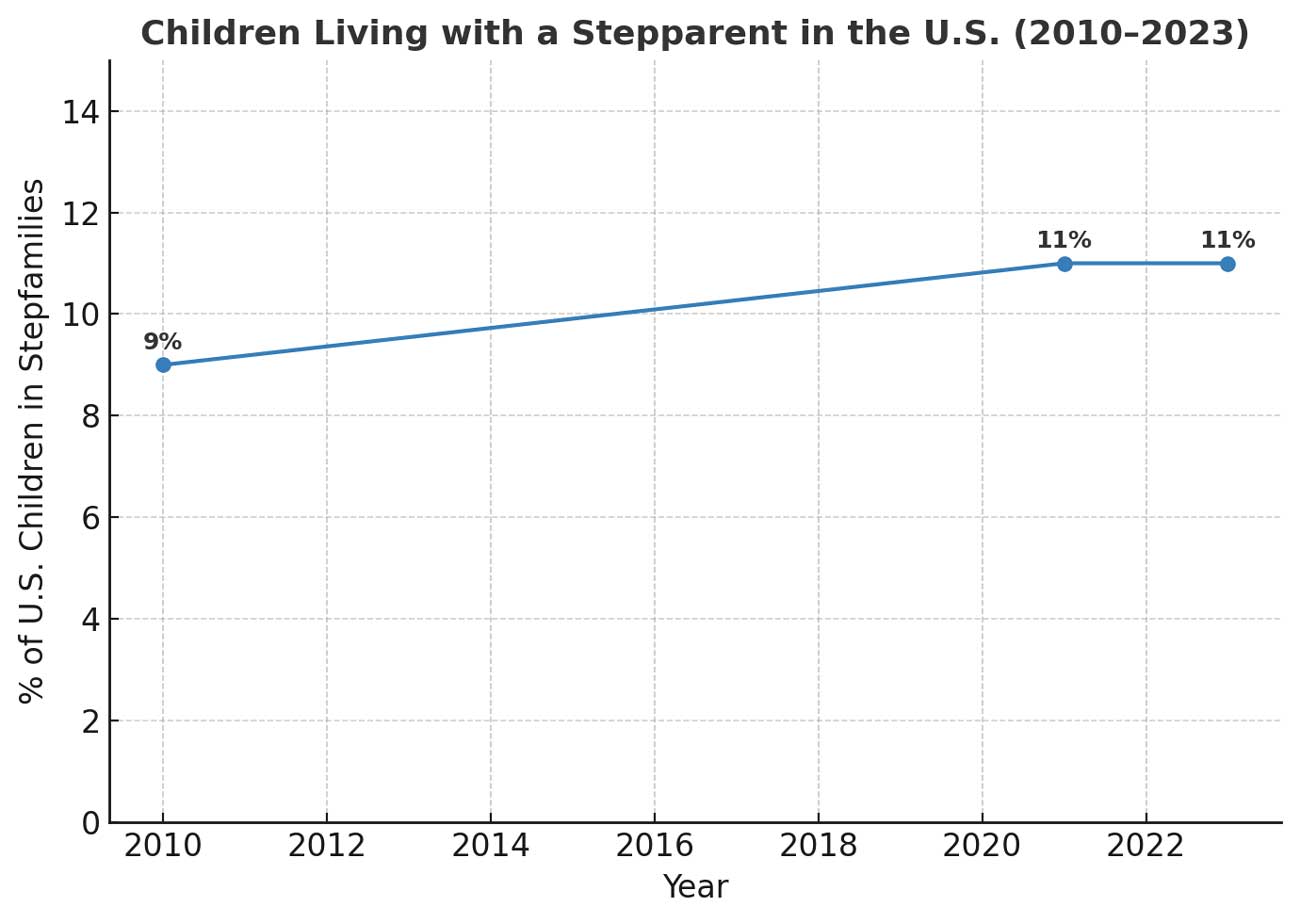
1. Custody Schedules
Nacho Parenting changes depending on how often kids are with you. In 50/50 custody, routines are the most critical factor. Each bio parent handles rules in their own home, and the stepparent steps back. When visiting on weekends or holidays, keep things light and calm. Use the time to connect, rather than control.
2. Young Kids and Teens
Young kids and teens can be particularly challenging for every blended family. In such a situation, the biological parents do need their partner’s help and sympathy. Teens may struggle to get along with their stepparents. However, with Nacho Parenting, everyone can overcome the challenges very well.
3. Special Needs for Special Children
Children with ADHD, autism, or other needs demand clear routines. Nacho Parenting can work, but it requires extra consistency. The bio parent sets the rules, while the stepparent supports care with patience. Professional help may also be required here.
4. Culture, Religion, and LGBTQ+ Families
Some families adhere to strong traditions or observe specific rituals. Diverse or non-traditional roles shape others. Nacho Parenting still works here, as long as roles are clear. Respect culture, language, and values, but keep the main rule: the bio parent leads discipline!
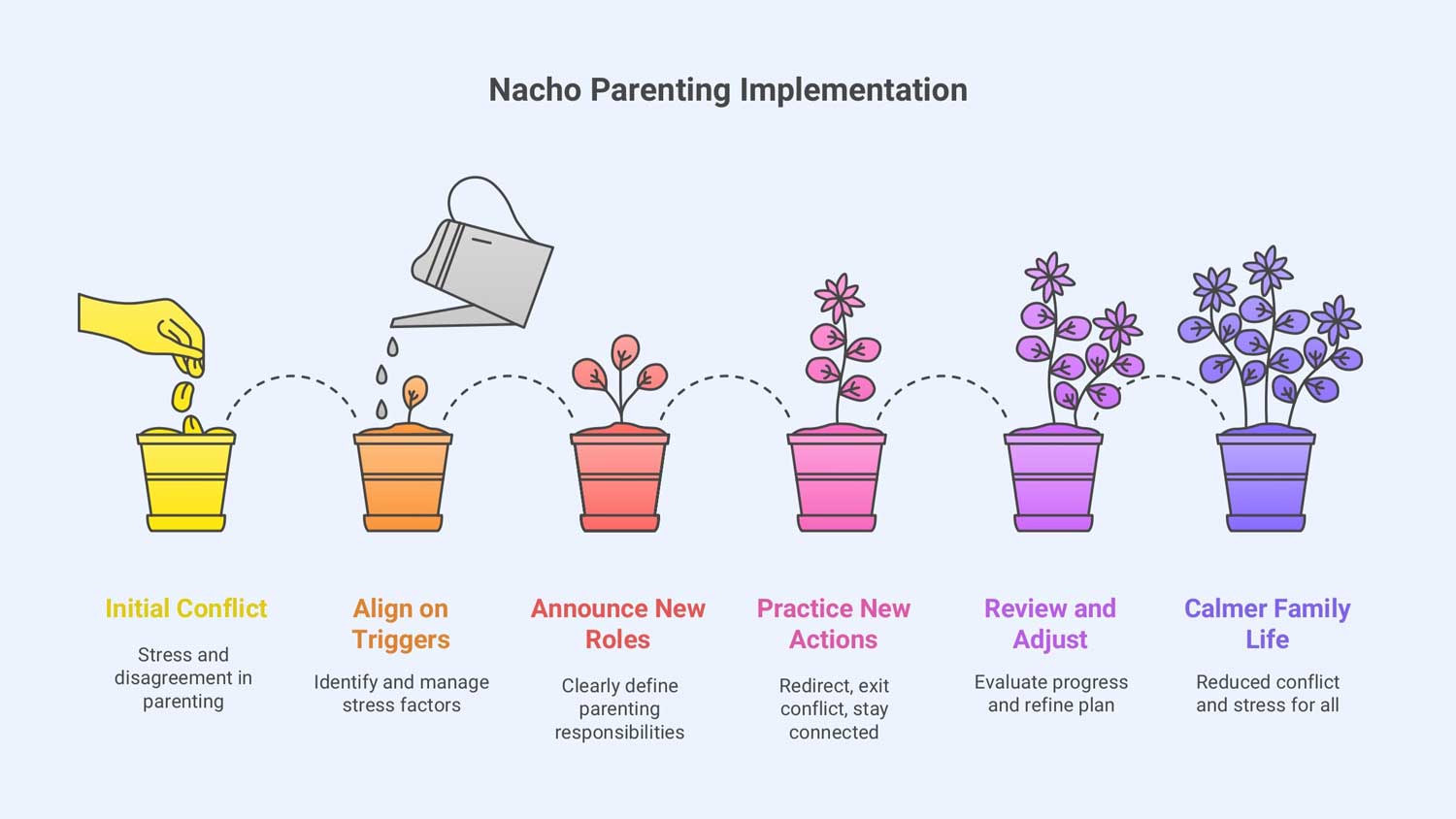
Real-Life Scenario: Weekend Visits Without the Power Struggles
Jenna used to spend weekends with her stepkids, Alex and Emma. She tried to enforce chores, but it always ended in fights. After trying Nacho Parenting, she stopped pushing chores during visits. Instead, they cooked pancakes, played Uno, and went for walks. At first, the kids were surprised. Soon, they started to enjoy weekends with her. The stress faded, and Jenna built a better relationship with her lovely kids.
When Nacho Parenting Is Not Enough and You Need Expert Help
Although practical and helpful, Nacho Parenting may not always be enough. In other words, you may need additional help to solve your family’s issues. Here are the signs that indicate you should call out for help:
- Fights continue to happen even after trying Nacho Parenting.
- The bio parent feels overloaded and stressed.
- The stepparent feels drained or resentful.
- Children often exhibit ongoing sadness, anger, or frustration.
- You and your partner stay stuck in the same arguments.
Expert therapies, specifically designed for couples and families, are the best way to teach you how to handle conflicts. Support groups are also a good idea for gathering families with similar struggles. You can also allow your children to talk to a counselor at school or a therapist at a clinic.
Practical Tools and Scripts for Nacho Parenting
Some ready-to-use tools make Nacho Parenting applicable for you. In the following, I have decided to share some of these tools with you and help get the most out of it:
A. Ready-to-Use Scripts for Stepparents
These short and simple sentences help you stay calm and keep clear roles:
- Permission ask: “That’s a parent call. let’s ask Mom/Dad.”
- Food/screens: “Your parents decided that. I’ll let them know you asked.”
- Conflict bait: “I’m not the decider here.” (Exit.)
- Polite opt-out: “I’m not the best person for this; your parent can help.”
- Kind help: “Sure, I can grab that for you.”
B. Weekly Check-In Guide for Couples
Spend 10 to 15 minutes each week with your partner. Use this checklist to stay in touch with each other and avoid small problems turning big:
- What went well this week?
- What was hard this week?
- Did we cross any boundaries?
- What can we change for next week?
- Who handles each decision coming up?
- Do we both feel supported?
- Is there one thing we can do better together?
C. Worksheets
These simple worksheets give structure and help you track progress:
- House-Impact Boundaries Map: Mark your spaces, your time, your property, and shared areas.
- 30-Day Plan: Write down your goals, scripts to use, triggers to avoid, and your re-engagement date.
- Re-Engagement Ladder: Add one step only when the last stays calm for 2–4 weeks.
Final Thoughts
Nacho Parenting offers blended families practical advice on how to coexist harmoniously with their children. Bio parents handle rules and discipline, while stepparents focus on being kind and supportive. Such clear boundaries mean you will face fewer conflicts, stress, and issues that may escalate into disasters. The method offers various stages that fit your family’s needs.
Whether you have applied any of the steps in Nacho Parenting or are new to it, please share your experiences with me and other blended families who are reading this post. Family Apex is committed to bringing calmness to every stage of your life.
Frequently Asked Questions About Nacho Parenting
1- Is Nacho Parenting forever?
No, it works in various stages of life. Blended families use Nacho Parenting to calm things down. However, they may need to make some adjustments based on new developments at home.
2- Can stepparents ever discipline in Nacho Parenting?
Yes. It is possible. But the bio-parent and the stepparent should both agree on this. The kids should also have a good relationship with their stepparents.
3- Does Nacho Parenting work for teens?
Yes. Nacho Parenting works very well for teens as it lowers the struggles. They know exactly who is in charge of setting the rules, so the blended families experience fewer conflicts.
4- What if the bio parent does not lead?
Generally speaking, Nacho parenting is based on the biological parents’ decisions about rules and discipline. If s/he does not, the Nacho Parenting does not take place either.
5- How do stepparents avoid looking uncaring with Nacho Parenting?
By showing kindness in small ways and staying connected. Share meals, play games, or lend a hand when you choose. Redirect discipline to the bio parent, but keep positive moments so kids see you care.

